2024 Karahori Site
Higashiagatsuma, Gunma Prefecture
Late to Final Jomon Period (ca. 4,500~2,500 years ago)
A mountain valley watering site revealing the livelihoods and ritual practices of Jomon people
The Karahori Site is located in a mountainous area of northwestern Kantō at an altitude of approximately 400 meters, situated on a narrow lower terrace in the midstream region of the Agatsuma River, overlooking the majestic cliffs of Mt. Iwabitsu. About 10 kilometers upstream are the scenic Agatsuma Gorge, the Yamba Dam, and the Kawarayu Onsen hot springs. Excavations were carried out as part of the construction of the Jōshin-etsu Expressway, uncovering watering site features, pit dwellings, pits, stone alignments, and stone clusters from the Late to Final Jomon periods. Artifacts recovered include pottery, stone tools, carved wooden posts, figurines, ear ornaments, stone artifacts, as well as numerous remains of horse chestnuts, walnut shells, and animal bones. Since only two pit dwellings were identified, the site is not considered a settlement but rather a production site for processing nuts.
A particularly noteworthy feature is the watering site. It was primarily constructed for soaking horse chestnuts in water to remove their tannins and was used continuously for over 200 years from the latter half of the Late Jomon period to the early part of the Final Jomon period (approximately 3,400–3,150 years ago). The feature, with a total length of about 20 meters, consisted of a reservoir, a workspace, a water channel, and a disposal area arranged sequentially from upstream to downstream.
The workspace was constructed atop a large flat boulder with a diameter of 1.6 meters, where clean water from the reservoir flowed over the chestnuts, and excess water was drained into the channel. In the valley area, a crescent-shaped stone alignment was built, likely as part of the water management system. The disposal area, where chestnut shells were discarded, contained multiple layers of accumulated shells, indicating extensive processing activities.
Additionally, a layer of ash was detected beside the workspace, suggesting that a method of tannin removal using ash (hai-awase) may have been employed. A carved wooden post was uncovered beneath the stone alignment of the water channel and is thought to have been intentionally buried in the watering site as part of ritual activities. This large, complete artifact measures 153 cm in length and 36 cm at its widest point. The round wooden post was processed into a square cross-section, with a U-shaped motif carved in relief on one side. The wood was identified as chestnut, and radiocarbon dating indicates it was felled approximately 3,240 years ago. This represents only the third discovery of a carved wooden artifact from the Jomon period, following finds at the Mawaki Site in Ishikawa Prefecture and the Shidanai Site in Iwate Prefecture, making it a valuable artifact for understanding the spiritual culture of the Jomon people.
A Shakōkidogū (goggle-eyed figurine) was also recovered, represented by a 12-cm-wide fragment of its head. It is estimated that the complete figurine would have stood approximately 30 cm tall, making it a fairly large example. The figurine is characterized by its large, rounded eyes and finely polished surface, with traces of red pigment remaining. The clay composition is finer than that of other figurines and pottery at the site, suggesting it was produced in the Tōhoku region, the center of the Kamegaoka Culture, and transported to the Karahori Site in Gunma Prefecture.
Other artifacts include jade pendants, magatama beads (comma-shaped beads), stone rods, stone plates, and dokko stones (polished stone implements similar in shape to Buddhist vajra), alongside mysterious stone objects resembling human figures and faces, evoking an almost fairy-like appearance. Additionally, around 800 clay ear ornaments, including fragments, were unearthed. These ear ornaments ranged in diameter from approximately 1 to 10 cm, featuring diverse patterns, some painted with red or black lacquer, suggesting the colorful adornment of Jomon individuals. Some of the ear ornaments also display U-shaped motifs similar to those on the carved wooden post.
The watering site yielded not only nut residues but also ritual-related artifacts, such as wooden posts, figurines, stone plates, and stone rods, as well as adornments like beads and ear ornaments. These findings indicate that the site functioned not only as a place for food processing but also as a venue for ritual activities.
The Karahori Site is highly significant for understanding the dietary practices, spiritual culture, and interregional exchanges of Jomon people who lived in the mountainous regions of northwestern Kantō. (Sekiguchi Hiroyuki)
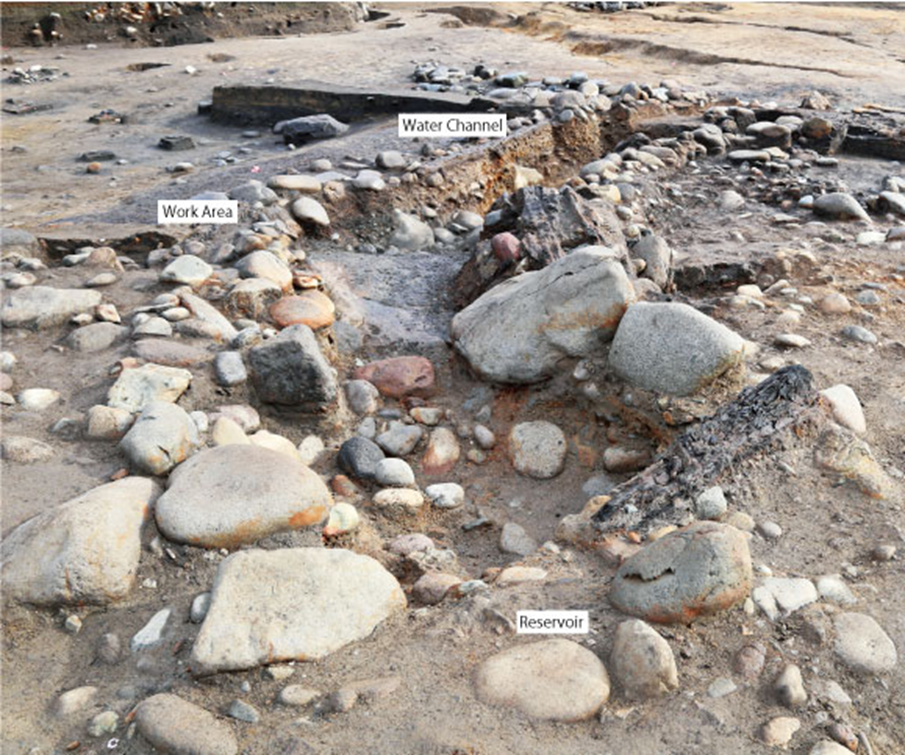
Watering Site (View from the West)
From the foreground upstream: Reservoir, Work Area, and Water Channel. The reservoir, work area, and water channel were constructed using stones and horizontal wooden beams. The large boulder visible at the bottom of the central work area marks its foundation.
Distant View of the Site (From the East) Full View of the Site (From the Southwest)
The watering site was constructed directly below the terrace cliff to utilize the abundant water flowing from its springs. At the foot of Mt. Iwabitsu, the Gōbara Site, famous for its heart-shaped clay figurine, is located nearby.
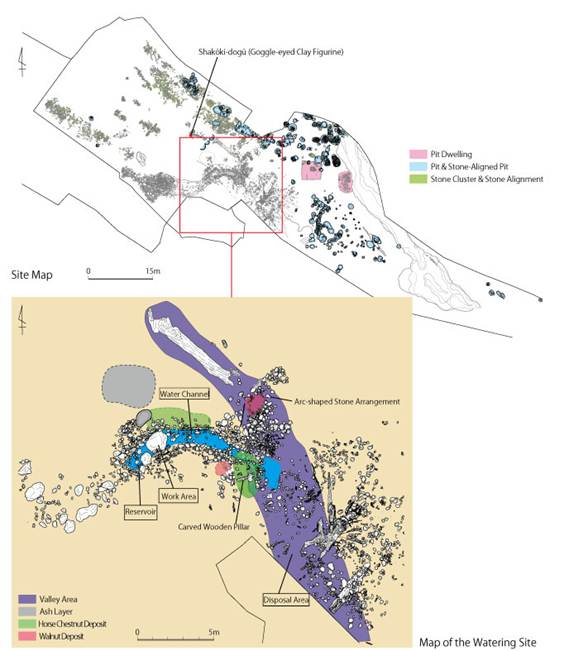
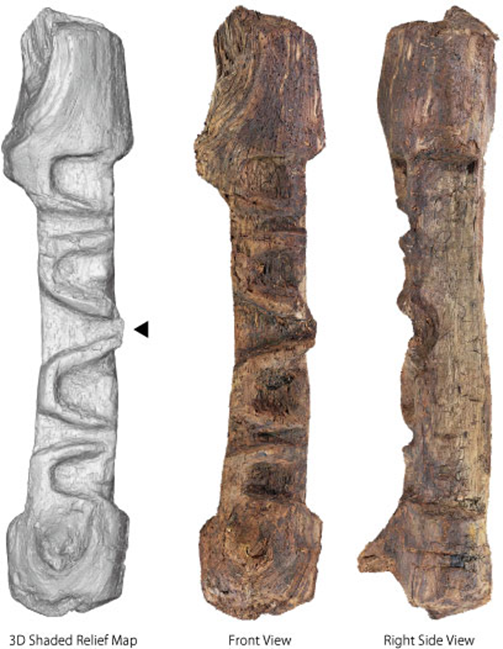
Carved Wooden Pillar
The carved wooden pillar is shaped into a square column with continuous U-shaped patterns carved into one side. The surrounding surface was shaved down to make the U-shaped patterns stand out in relief. A protrusion is present at the center of the pillar (marked by the triangle), serving as a reference point for carving. The U-shaped patterns were symmetrically arranged both above and below this point, with identical shape, size, depth, and spacing. This is a fully intact artifact, made of chestnut wood (Castanea spp.), measuring 153 cm in length and 36 cm in maximum width, with the carved section extending 87 cm in length and 23 cm in width. The height of the carved patterns ranges between 3 and 5 cm. It dates to the Late Jomon period (approximately 3,240 years ago).
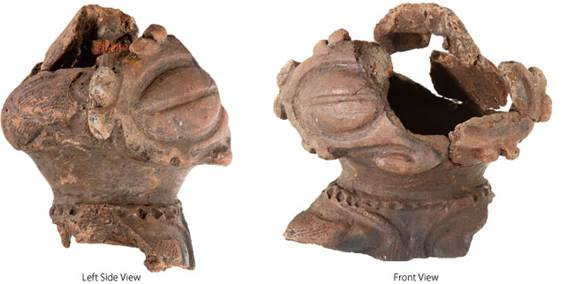
Fragment of a Shakōki-dogū (Goggle-eyed Clay Figurine) Head
Characterized by its large, round, and bulging eyes, this fragment exhibits a carefully polished surface. Traces of red pigment remain faintly in the gaps between the patterns. No fragments of the torso, arms, or legs were found. It measures 9.3 cm in height and 12 cm in width and dates to the Final Jomon period (approximately 3,100 years ago).
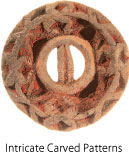
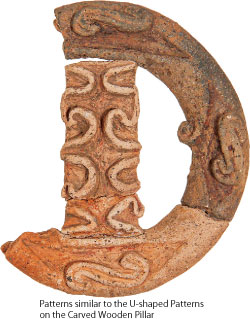
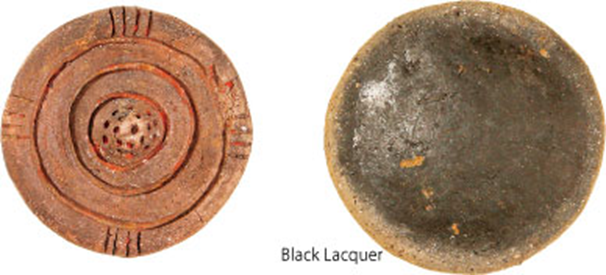
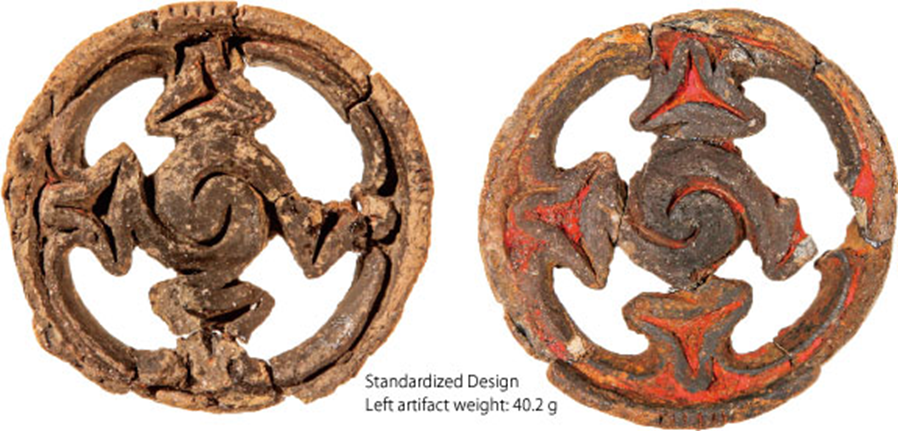
Clay Ear Ornaments
A total of approximately 800 pieces, including both complete and fragmented examples, were excavated. All are circular in shape, with diameters ranging from 8 mm to 106 mm. While their sizes and patterns vary, one matching pair was found with identical dimensions and designs, suggesting a standardized production. Some pieces were coated in red pigment, while others were black lacquered. Additionally, some exhibit patterns resembling the U-shaped carvings on the carved wooden pillar.